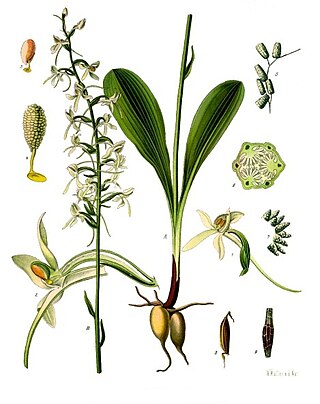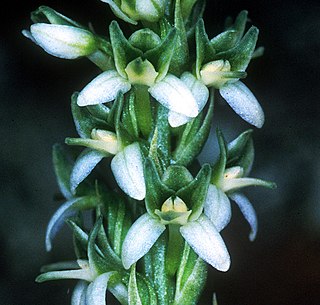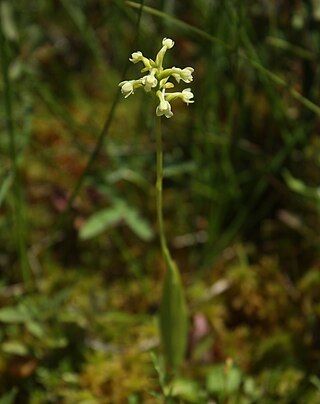
Orchids are plants that belong to the family Orchidaceae, a diverse and widespread group of flowering plants with blooms that are often colourful and fragrant. Orchids are cosmopolitan plants that are found in almost every habitat on Earth except glaciers. The world's richest diversity of orchid genera and species is found in the tropics.

Anacamptis pyramidalis, the pyramidal orchid, is a perennial herbaceous plant belonging to the genus Anacamptis of the family Orchidaceae. The scientific name Anacamptis derives from Greek ανακάμτειν 'anakamptein' meaning 'bend forward', while the Latin name pyramidalis refers to the pyramidal form of the inflorescence.

Gymnadenia conopsea, commonly known as the fragrant orchid or chalk fragrant orchid, is a herbaceous plant of the family Orchidaceae native to northern Europe.

Anacamptis is a genus of flowering plants in the orchid family (Orchidaceae); it is often abbreviated as Ant in horticulture. This genus was established by Louis Claude Richard in 1817; the type species is the pyramidal orchid and it nowadays contains about one-third of the species placed in the "wastebin genus" Orchis before this was split up at the end of the 20th century, among them many that are of hybrid origin. The genus' scientific name is derived from the Greek word anakamptein, meaning "to bend backwards".

Dactylorhiza majalis, the broad-leaved marsh orchid, is a terrestrial Eurasian orchid.

Platanthera bifolia, commonly known as the lesser butterfly-orchid, is a species of orchid in the genus Platanthera, having certain relations with the genus Orchis, where it was previously included and also with the genus Habenaria. It is a Palaearctic species occurring from Ireland in the west, across Europe and Asia to Korea and Japan. It is also found in North Africa. The name Platanthera is derived from Greek, meaning 'broad anthers', while the species name, bifolia, means 'two leaves'.

Piperia is a former genus within the orchid family Orchidaceae that has since been subsumed under Platanthera.
Butterfly orchid is a common name for several orchids and may refer to:

Platanthera chlorantha, commonly known as greater butterfly-orchid, is a species of orchid in the genus Platanthera. It can be found throughout Europe and Morocco. The name Platanthera is derived from Greek, meaning "broad anthers", while the species name, chlorantha, means "green-flowered".

Platanthera blephariglottis, commonly known as the white fringed orchid or white-fringed orchis, is a species of orchid of the genus Platanthera. It is considered to be an endangered species in Connecticut and Ohio, a threatened species in Florida, Maryland and Rhode Island, exploitably vulnerable in New York, and susceptible to be threatened in Québec.

Dactylorhiza maculata, known as the heath spotted-orchid or moorland spotted orchid, is an herbaceous perennial plant of the family Orchidaceae. It is widespread in mountainous regions across much of Europe from Portugal and Iceland east to Russia. It is also found in Algeria, Morocco, and western Siberia.

Orchideae is a tribe of orchids in the subfamily Orchidoideae. Historically, it was divided into 2 subtribes, Orchidinae and Habenariinae. The subtribe Orchidinae alone contains about 1,800 species. However, although some phylogenetic studies have established the monophyly of the subtribes, the generic boundaries are unclear, with many genera as traditionally circumscribed being paraphyletic or even polyphyletic. Species of genera such as Habenaria and Platanthera have been placed into both subtribes. A 2017 molecular phylogenetic study found that both subtribes did form clades, but did not formally recognize Habenariinae, because of missing genera and uncertainty over generic boundaries. The Asian species of Orchideae, in particular, have been subject to repeated changes of generic placement from 2012 onwards.

Habenaria rumphii, commonly known as the stiff rein orchid, is a species of orchid that is widespread and common in Southeast Asia, New Guinea and northern Australia. It has six or seven leaves on the lower part of its stem and up to thirty white flowers with one long and two short lobes on the labellum.

Platanthera dilatata, known as tall white bog orchid, bog candle, or boreal bog orchid is a species of orchid, a flowering plant in the family Orchidaceae, native to North America. It was first formally described in 1813 by Frederick Traugott Pursh as Orchis dilatata.

Platanthera clavellata, commonly known as the club-spur orchid or small green wood orchid, is a terrestrial orchid of North America.

Platanthera aquilonis, the northern green orchid or north wind bog orchid, is a species of self-fertilizing orchid native to the United States and Canada with a widespread distribution across the two countries.

Platanthera pallida, commonly known as pale fringed orchid, is a rare orchid of North America with the only known occurrences on Long Island.

Platanthera tipuloides, the Aleutian Bog Orchid or Bering Bog Orchid, is a terrestrial orchid native to the United States, Russia, China, Japan and Korea.

Platanthera chorisiana, Chamisso's orchid or Choris' bog orchid, is a terrestrial orchid native to the United States, Canada, Russia and Japan.




















